Related Research Articles

Pope Paul VI was head of the Catholic Church and sovereign of the Vatican City State from 21 June 1963 to his death in August 1978. Succeeding John XXIII, he continued the Second Vatican Council, which he closed in 1965, implementing its numerous reforms. He fostered improved ecumenical relations with Eastern Orthodox and Protestant churches, which resulted in many historic meetings and agreements. In January 1964, he flew to the Hashemite Kingdom of Jordan. This was the first time a reigning pontiff had flown on an airplane, the first papal pilgrimage to the Holy Land, and the first time a Pope had left Italy in more than a century.

The World Council of Churches (WCC) is a worldwide Christian inter-church organization founded in 1948 to work for the cause of ecumenism. Its full members today include the Assyrian Church of the East, the Oriental Orthodox Churches, most jurisdictions of the Eastern Orthodox Church, the Old Catholic Church, the Lutheran churches, the Anglican Communion, the Mennonite churches, the Methodist churches, the Moravian Church, Mar Thoma Syrian Church and the Reformed churches, as well as the Baptist World Alliance and Pentecostal churches. Notably, the Catholic Church is not a full member, although it sends delegates to meetings who have observer status.
Full communion is a communion or relationship of full agreement among different Christian denominations or Christian individuals that share certain essential principles of Christian theology. Views vary among denominations on exactly what constitutes full communion, but typically when two or more denominations are in full communion it enables services and celebrations, such as the Eucharist, to be shared among congregants or clergy of any of them with the full approval of each.

Ecumenism – also called interdenominationalism, transdenominationalism, or ecumenicalism – is the concept and principle that Christians who belong to different Christian denominations should work together to develop closer relationships among their churches and promote Christian unity. The adjective ecumenical is thus applied to any interdenominational initiative that encourages greater cooperation and union among Christian denominations and churches.

The Week of Prayer for Christian Unity is an ecumenical Christian observance in the Christian calendar that is celebrated internationally. It is kept annually between Ascension Day and Pentecost in the Southern Hemisphere and between 18 January and 25 January in the Northern Hemisphere. It is an octave, that is, an observance lasting eight days.
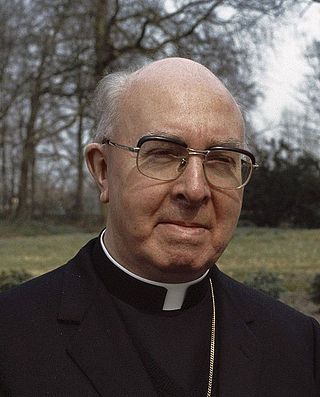
Johannes Gerardus Maria Willebrands was a Dutch Cardinal of the Roman Catholic Church. He served as President of the Pontifical Council for Promoting Christian Unity from 1969 to 1989, and Archbishop of Utrecht from 1975 to 1983. Elevated to the cardinalate in 1969, Willebrands was central to the increased ecumenism of the Church in the second half of the 20th century, and was considered papabile at the two conclaves held in 1978.
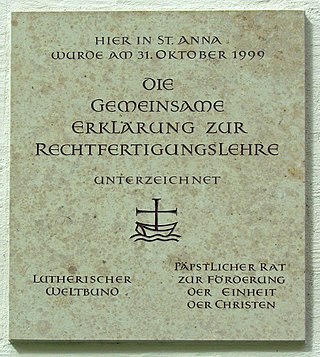
The Joint Declaration on the Doctrine of Justification (JDDJ) is a document created and agreed to by the Catholic Church's Pontifical Council for Promoting Christian Unity (PCPCU) and the Lutheran World Federation in 1999 as a result of Catholic–Lutheran dialogue. It states that the churches now share "a common understanding of our justification by God's grace through faith in Christ." To the parties involved, this essentially resolves the 500-year-old conflict over the nature of justification which was at the root of the Protestant Reformation. The World Methodist Council adopted the Declaration on 18 July 2006. The World Communion of Reformed Churches, adopted the Declaration in 2017.
Catholic–Lutheran dialogue is a series of discussions which began during July 1964 as an outgrowth of the Second Vatican Council. These gatherings reflect the new openness of the Catholic Church to dialogue with other Christian denominations as well as other religions. These dialogues have been primarily between representatives of the Lutheran World Federation and representatives of the Pontifical Council for Promoting Christian Unity.
Ut unum sint is an encyclical by Pope John Paul II of 25 May 1995. It was one of 14 encyclicals issued by John Paul II. Cardinal Georges Cottier, Theologian emeritus of the Pontifical Household, was influential in drafting the encyclical.
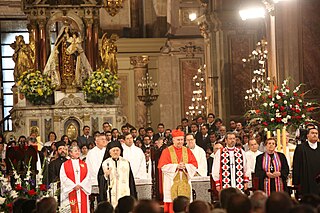
The Catholic Church has engaged in the modern ecumenical movement especially since the Second Vatican Council (1962-1965) and the issuing of the decree Unitatis redintegratio and the declaration Dignitatis humanae. It was at the Council that the Pontifical Council for Promoting Christian Unity was created. Those outside of the Catholic Church were categorised as heretics or schismatics, but in many contexts today, to avoid offence, the euphemism "separated brethren" is used.
Branch theory is an ecclesiological proposition that the One, Holy, Catholic, and Apostolic Church includes various different Christian denominations whether in formal communion or not. The theory is often incorporated in the Protestant notion of an invisible Christian Church structure binding them together.
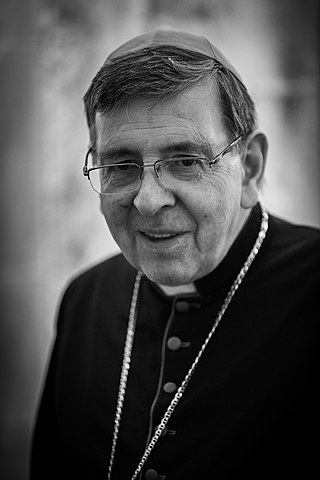
Kurt Koch is a Swiss prelate of the Catholic Church. He has been a cardinal since November 2010 and president of the Dicastery for Promoting Christian Unity since 1 July 2010. He was the bishop of Basel from 1996 until 2010.

Ecumenical meetings and documents on Mary, involving ecumenical commissions and working groups, have reviewed the status of Mariology in the Eastern Orthodox, Lutheran, Anglican, and Roman Catholic Churches.
Georges Henri Tavard, AA was an ordained member of the Augustinians of the Assumption. He lectured extensively in the areas of historical theology, ecumenism, and spirituality.
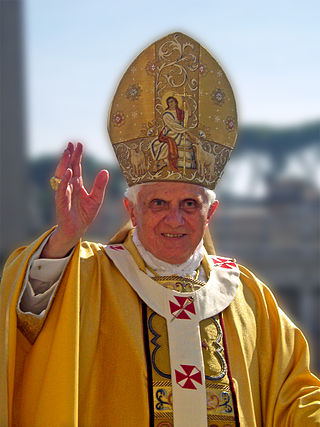
Pope Benedict XVI, who led the Roman Catholic Church as Pope from 2005 to 2013, continued manouevring the Church through the dynamics of modernity, which the Church had begun engaging in with the Second Vatican Council. Because the question of religious pluralism is a key issue raised by modernity, ecumenism, the establishment of harmony and dialogue between the different Christian denominations, is a significant concern of a post Second Vatican Council Church. Pope Benedict XVI's approach has been characterised as leaning toward the conservative while still being expansive and engaged, involving the full breadth of Christendom, including the Orthodox Churches and Protestant churches, as well as freshly engaging with other Christian bodies considered by Roman Catholics to be more heterodox, such as the Church of Jesus Christ of Latter-day Saints.
Anglican–Roman Catholic dialogue is the historical communication between the Anglican Communion and the Roman Catholic Church, through their ecumenical relations. These were notably shaped subsequent to the Second Vatican Council (1962–1965).
The Dicastery for Promoting Christian Unity, previously named the Pontifical Council for Promoting Christian Unity (PCPCU), is a dicastery within the Holy See whose origins are associated with the Second Vatican Council which met intermittently from 1962 to 1965.
Sister churches was a term used in 20th-century ecclesiology to describe ecumenical relations between the Roman Catholic Church and the Eastern Orthodox Churches, and more rarely and unofficially, between the Roman Catholic Church and the Anglican communion. The Catholic Church has since called on theologians to avoid the term, clarifying that "one cannot properly say that the Catholic Church is 'sister' of a particular Church or group of Churches. This is not merely a question of terminology, but above all of respecting a basic truth of the Catholic faith: that of the unicity [uniqueness] of the [Catholic Church]." The term is also currently used among Protestants to refer to different denominations of the same religious tradition.

Catholic–Eastern Orthodox relations have warmed over the last century, as both churches embrace a dialogue of charity. The Second Vatican Council (1962-1965) ushered in a new era of relations for the Catholic Church towards the Eastern Church, fondly describing the Orthodox as “separated brethren” with valid sacraments and an apostolic priesthood. The Orthodox Church, on the other hand, encouraged local churches to prepare for future dialogue in the Third Pan-Orthodox Conference in Rhodes (1964), and has since engaged in several ecumenical efforts with the Vatican. Significantly, in 1965 Pope Paul VI and Ecumenical Patriarch Athenagoras I of Constantinople mutually lifted their respective excommunications.

Pope Francis has had main contacts with those of other Christian faiths, with those of other religious beliefs, and with non-believers.
References
- ↑ Hebblethwaite 273
- ↑ Hebblethwaite 714-715
- ↑ Schmidt 811-812
- ↑ Guitton 177
- ↑ Guitton 181
- ↑ Guitton 185
- ↑ Schmidt 822-824
- ↑ Schmidt 826
- ↑ Schmidt 827.
- ↑ Schmidt 835
- ↑ Schmidt 837
- 1 2 Franzen 429
- ↑ Schmidt 830,
- ↑ Schmidt 833
- ↑ Schmidt 831
- ↑ Guitton 198
- 1 2 3 Schmidt 813
- ↑ and John XXIII
- ↑ Schmidt 814
- ↑ Schmidt 815
- ↑ Responses to Some Questions Regarding Certain Aspects of the Doctrine on the Church